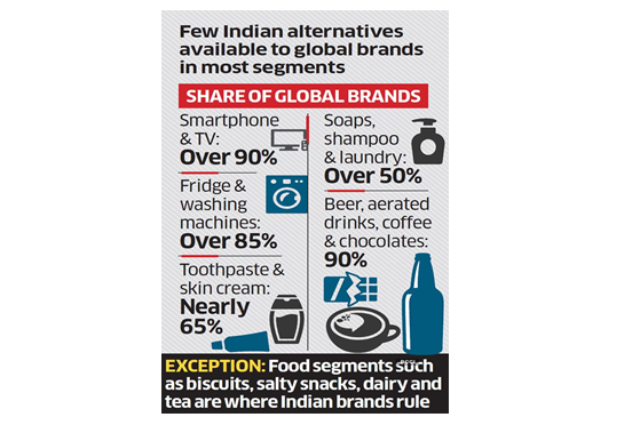
Image by Gerd Altmann from Pixabay
THE STORY SO FAR
The Indian consumer is slowly but surely, becoming what is known as a global consumer. Post-liberalization in the 1990s, as the Indian market got flooded with foreign goods and brands, the loyalty that we Indians harbour towards goods of foreign origin (in certain product categories), has only been on the rise. However, the state in which the world finds itself in, in 2020, and India especially, with its peculiarly aggressive neighbours and a “vocal for local” national leadership, has started a wave of pro-local consumer sentiment worldwide. Segments such as mobile phones, consumer electronics, beauty, apparels etc. which were traditionally dominated by foreign brands, are now seeing, at least in principle, a tidal shift towards local brands. However, constraints in the form of quality, pricing, and to put simply, brand positioning, continue to limit the impact that this surge of sentiments has on the actual sales of global and local brands.
THE CURRENT PICTURE
THE ENTRY OF THE INTERNATIONAL PLAYER
“Adversity brings us all together”
In the past few decades, Indian masses have become more welcoming of international products, across all walks of life. This rapid incorporation of the international market into the domestic consumer’s basket started with the advent of liberalisation. It has been a blessing for the Indian players and manufacturers as well, since to remain competitive in the markets, local players have had to ‘up their game’ literally and have consequently improved across the parameters of performance, quality and even their efficacy.
Regardless, from a market-demand perspective, international brands have managed to make considerable headway into the markets and have captured large chunks of the Indian luxury as well as the middle-class market. The biggest driver of this growth-in-preference for these goods has been their quality assurance and association with a higher socio-cultural image, which has persisted despite their higher prices when compared to their Indian counterparts.
GLOBALISATION DRIVEN GROWTH
Globalisation and mass-media have had their fair share to play in this growth. They have catalysed awareness and aspirations towards attaining an international lifestyle and cultural assimilation within a population which does not mind paying extra, for assurances of quality and popular appeal.
THE VOICE FOR LOCAL OVER GLOBAL
THE NATIONALISM TWIST
However, one factor that supersedes all of this is the feeling of patriotism-and-nationalism. The wave of nationalism that has gripped governments across the world has been a primary challenge to the presence of international brands in diverse economies and geographies. Additionally, what is peculiar about this sudden shift is that only imports are being discouraged. Traditionally, curbing imports has also implied the curbing of exports as well, but right now all economies want their public to consume local while producing globally. This can be due to the disruptions in global supply chains brought about by the pandemic, an attempt to save precious foreign exchange or simply to bolster domestic industries.
Brand positioning then becomes a key part of the narrative. And Local brands need to leverage their “country-of-origin” roots to gain a competitive advantage over larger, well-established foreign brands, who have much deeper pockets. A great example would be that of Patanjali, which built an empire for its products, effectively leveraging the nationalistic narrative.
PATRIOTISM & PHILOSOPHY
From an Indian perspective, the recent events around the world, be it the impact of the COVID-pandemic on global supply chains and the ensuing shortages in product-choices or the military stand-offs against China, international political issues have always impacted consumer preferences. Such events have forced countries to look inwards and promote domestic industries and products.
However, in the age of globalization, no country can continue to remain an island. As international trade normalizes and the glaring lack of substitutes for Chinese products (mobile phones, electronics, APIs etc.) becomes evident, consumers will go back to international brands, simply because of the lack of substitutes both in terms of price and quality. Local brands need to constantly reinvent themselves, amidst constant political and economic chaos, as from a national perspective, just being national will not be enough.
THE IMPACT ON BRANDS
Before understanding what sort of an impact this new campaign has had on global as well as local brands, let us first understand what a brand is. A brand is a conglomeration of the product’s function, value-proposition, consumer-connect and levels of differentiation vis-a-vis other similar brands. So even though the choice-making process seems arbitrary at first sight, it depends on multiple consumer-specific factors which in turn shapes the demand at the macro-level.
SURGE IN DEMAND FOR LOCAL
The pandemic has been a blessing in disguise for local brands. Even though the initial months of the lockdown were especially tough for local brands, especially the MSMEs, the pitch for “vocal for local” has indeed helped shift consumer preferences towards Indian brands and products. A better understanding of local consumer preferences as well as hyper-local supply chains, gave such brands a natural advantage over well-established foreign brands. Going ahead, as people shift back to their pre-COVID patterns of consumption, local brands need to continue reinventing themselves, and move beyond just the “vocal for local” narrative, to drive long-term brand-loyalty and value.
IMPULSIVITY BOOST BY LOCAL BRANDS
A key factor why local brands trump over international brands, especially in certain segments, also lies in the psychological distance between the consumer and the attributes that the brand/product projects. This smaller distance makes the features more concrete, immediate, relevant and easier for the consumer to relate to the product. Thus, this psychology-driven impulsivity increases the likeliness of a purchase taking place.
EFFECT ON CONSUMER-BASED BRAND EQUITY AMONG STATUS-SEEKERS
According to multiple research studies, when choosing between country-of-origin brands and foreign brands, consumers who possess the purchasing power to cover both ends of the price spectrum, have a strong preference for the latter. This is explained as “status-seeking behaviour”, and such consumers are known as “status seekers”. What drives this behaviour? The simple principle of scarcity and rarity. The brand association, perceived quality, and brand loyalty for such customers, is extremely high for foreign brands. This displays the success of aspirational global branding strategies, which makes foreign brands “aspirational”.
Whereas on the other end of the spectrum, consumer ethnocentrism promotes aspects which are culturally similar and rejects dissimilar aspects. It harps not just on quality, but on “perceived quality”. Again, multiple factors impact consumer perception. Take the case of India’s recent standoff with China. The military stand-offs on the LAC, did not alter the quality of popular Chinese mobile phones in India. But the swell of patriotism did alter the “perceived quality” and impacted the sales of such brands, albeit for a short time period.
THE WAY FORWARD
WHICH BRANDS NEED TO DO WHAT?
An interesting factor within these brand preferences, has been the relevance of the segments themselves. Segments such as electronics, branded apparels, mobile phones etc. have a strong foreign appeal, whereas for segments such as food-products (dairy), tea, biscuits etc., local tastes, experiences and relationships matter much more. Thus, it becomes imperative for a brand to identify the inherent nature of the segment it belongs to and strategize its branding activities accordingly.
IS VOCAL FOR LOCAL SUSTAINABLE?
Regardless of what the public appeal is, the fact of the matter is that it is easier said than done. One can make the people want to switch over from global to local brands, but it is easier said than done. As the following infographic shows, there aren’t many alternatives to credible international consumer-products that have become an almost essential part of our daily lives.

Hence, it is very likely that the sudden surge seen in the demand for local over global, is indeed short-lived. It is unsustainable in the long-run. It will lose steam the moment when the nationalism and patriotism-driven shift in preference begins to hinder consumer convenience.
. . .
REFERENCES:
- https://core.ac.uk/download/pdf/288022849.pdf
- https://www.business-standard.com/article/specials/local-vs-global-brands-for-india-from-india-116122801251_1.html
- https://www.researchgate.net/publication/335436988_Go_local_or_go_global_how_local_brands_promote_buying_impulsivity#fullTextFileContent
- https://www.warc.com/newsandopinion/opinion/beyond-patriotism-are-indian-brands-ready-to-win-local-and-be-global/3703
- https://www.afaqs.com/news/pov/will-nationalist-sentiment-increase-demand-for-local-brands
- https://www.indiaretailing.com/2020/07/30/retail/vocal-for-local-homegrown-brands-experience-surge-in-demand/
- https://www.nielsen.com/wp-content/uploads/sites/3/2019/04/nielsen-report-global-mncs-and-local-giants-winning-in-india.pdf
